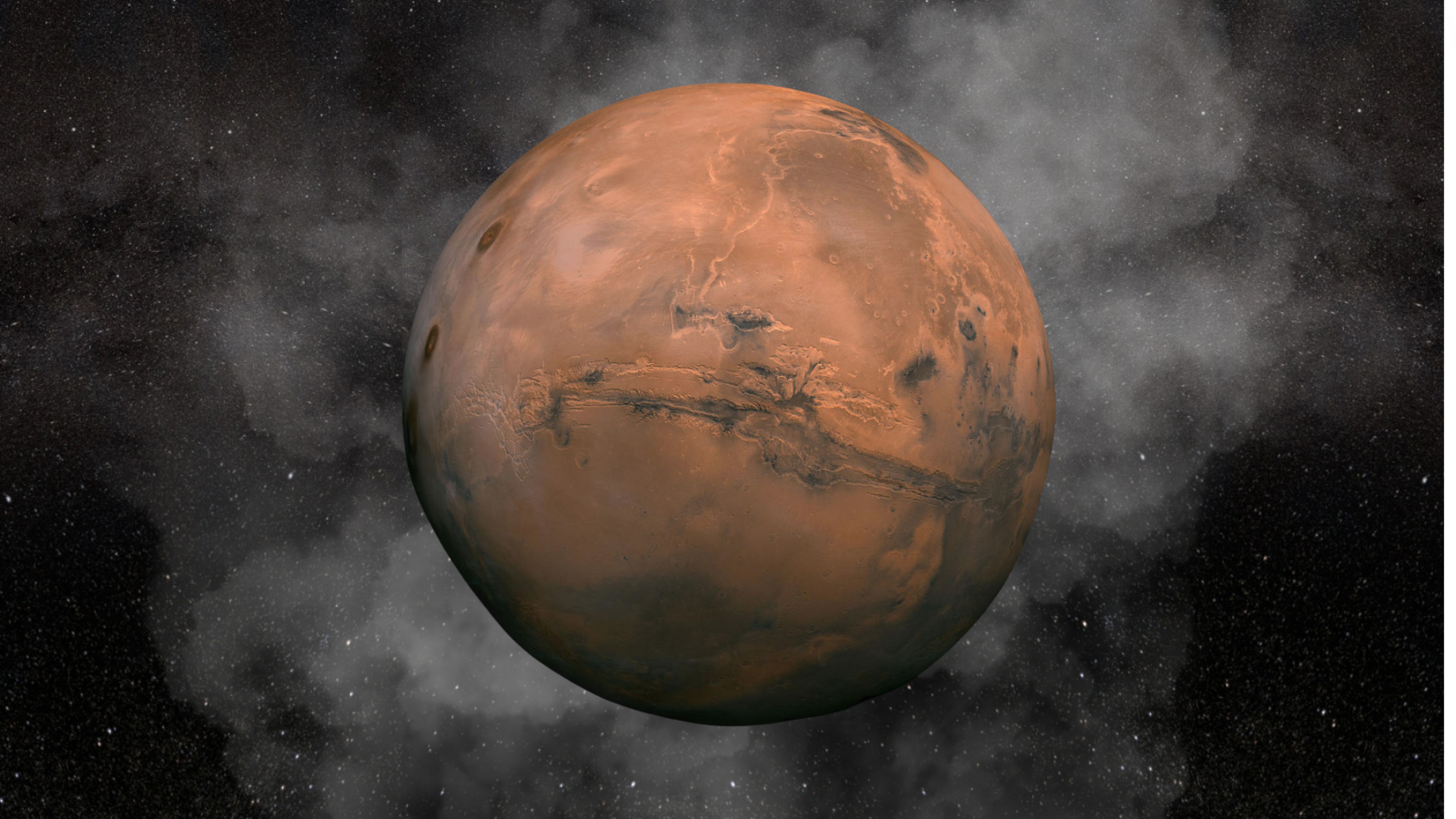Where did Mars' atmosphere go? Scientists say it may be 'hiding in plain sight'
"Mars' missing atmosphere could be hiding in plain sight."

New research suggests the atmosphere of Mars may be hiding in plain sight, having been absorbed by minerals in the Red Planet's clays. If Mars' envelope of gas did "go to ground" over 3 billion years ago, this could explain how Earth's neighboring planet became so different from our world, potentially losing its capability to host life.
Scientists know that the Red Planet wasn't always the arid and barren landscape that the Mars rovers Perseverance and Curiosity trundle across today. Both of NASA's rolling robots have uncovered evidence that abundant water flowed over Mars early in its 4.6 billion-year history. But for Mars to have had liquid water, it must also have possessed an atmosphere to stop this water from freezing. The big question for decades has been: where did this atmosphere go when disappeared?
A team of researchers think that the answer has been under the noses (or the tracks) of Curiosity and Perseverance all this time. In a paper published in Science Advances, they argue that while water was present on the Red Planet, it may have trickled through certain rock types and set off a slow series of reactions that slurped carbon dioxide out of the atmosphere. This would have then been converted into methane, a form of carbon, and locked up in the clay surface of Mars.
"Based on our findings on Earth, we show that similar processes likely operated on Mars and that copious amounts of atmospheric carbon dioxide could have transformed to methane and been sequestered in clays," team member Oliver Jagoutz, professor of geology at the Massachusetts Institute of Technology’s Department of Earth, Atmospheric and Planetary Sciences (MIT EAPS), said in a statement. "This methane could still be present and maybe even used as an energy source on Mars in the future."
Related: NASA's Perseverance Mars rover is enroute to conduct 1st crater rim study at 'Dox Castle'
How Earth pointed the way in Mars atmosphere mystery
Working within his group at MIT, Jagoutz and colleagues didn't begin their investigation with Mars but with our own planet. The scientists were attempting to determine what geological processes drive the evolution of the hard yet brittle outer shell layer of Earth that encompasses the crust and the upper mantle, and is known as the lithosphere.
The researchers concentrated on a type of surface clay mineral called "smectite," which is very efficient at trapping carbon. Just one grain of smectite is composed of many folds in which carbon can sit and remain for billions of years without being displaced or disturbed.
Breaking space news, the latest updates on rocket launches, skywatching events and more!
On Earth, smectites are created by the movement of tectonic plates upon which the continents sit. This tectonic activity also lifted smectites to our planet's surface. When exposed to the surface, this folded clay mineral drew in carbon dioxide, removing this greenhouse gas from the atmosphere and helping our planet cool down over millions of years.
The team shifted focus to Mars when Jagoutz looked at the surface of the Red Planet, and he noticed similar smectite matter dispersed across Earth's neighbor.

The discovery of smectites on Mars posed an important question: Since the Red Planet lacks tectonic activity, how was this folded clay mineral created? To answer this query, the team turned to what they knew about the geological history of Earth's neighbor.
One clue was the remote detection of igneous rocks with low silica content in the crust of the Red Planet called "ultramafic rocks." On Earth, these igneous rocks have been known to create smectites when they are corroded or "weathered" by water. On Mars, there is evidence of ancient rivers where water could have flowed and reacted with the underlying rock.
The team then used knowledge of the interaction of water and igneous rocks on Earth to create a model to apply to Mars. The model would reveal if water could have reacted with deep Martian ultramafic rocks in a way that would produce smectites at the surface today.
Using this model, the scientists found that over the course of a billion years, water could have seeped through the crust to react with a magnesium-iron silicate mineral abundant in igneous rock called "olivine." This mineral is rich in iron, which the oxygen in water would have bound itself to in the process, releasing hydrogen. This oxidized iron may have helped to give Mars its distinctive red color.
Next, the freed hydrogen could have combined with carbon dioxide in the water to create methane, with this reaction slowly transforming olivine into another rock rich in iron called "serpentine." As serpentine continued to react with water, this could have finally forged smectites.
"These smectite clays have so much capacity to store carbon," researcher lead author and MIT EAPS graduate Joshua Murray said in the statement. "So then we used existing knowledge of how these minerals are stored in clays on Earth, and extrapolate to say, if the Martian surface has this much clay in it, how much methane can you store in those clays?"
The team found that to store the amount of methane needed to leach most of the carbon dioxide from the atmosphere of Mars, the Red Planet would have had to be covered with a layer of smectite over 3,600 feet (1,100 meters) deep.
"We find that estimates of global clay volumes on Mars are consistent with a significant fraction of Mars' initial carbon dioxide being sequestered as organic compounds within the clay-rich crust," Murray concluded. "In some ways, Mars' missing atmosphere could be hiding in plain sight."
The team's research was published Sept. 25 in the journal Science Advances.
Join our Space Forums to keep talking space on the latest missions, night sky and more! And if you have a news tip, correction or comment, let us know at: community@space.com.

Robert Lea is a science journalist in the U.K. whose articles have been published in Physics World, New Scientist, Astronomy Magazine, All About Space, Newsweek and ZME Science. He also writes about science communication for Elsevier and the European Journal of Physics. Rob holds a bachelor of science degree in physics and astronomy from the U.K.’s Open University. Follow him on Twitter @sciencef1rst.
-
Balter Mars has never had a significant atmosphere and never will: it is simply too small and does not have the required gravity to hold on to an atmosphere.Reply -
Mex Sure it did. We know that Mars had a much denser atmosphere than it does today because we've found iron meteorites on the surface of Mars that were heated as they fell. And Jupiter's moon Titan has an atmosphere that's 2 ATA on the surface, twice the surface pressure of our atmosphere on Earth, in spite having far less gravity than Mars.Reply -
billslugg Venus has 2.4 times the gravity of Mars.Reply
Venus ionosphere generates a sufficient magnetic field to protect the atmosphere from stripping.
Venus may also be replenishing the atmosphere from volcanic activity. -
SeldonCrisisJoel Reply
The article mentions the potential use for fuel, but the question that occurs to me is how the carbon in the smectites could be reconverted into atmosphere?Mex said:Sure it did. We know that Mars had a much denser atmosphere than it does today because we've found iron meteorites on the surface of Mars that were heated as they fell. And Jupiter's moon Titan has an atmosphere that's 2 ATA on the surface, twice the surface pressure of our atmosphere on Earth, in spite having far less gravity than Mars. -
Torbjorn Larsson Nice! That may solve that mystery.Reply
The induced field protects somewhat from the solar wind but the atmosphere is stripped:billslugg said:Venus has 2.4 times the gravity of Mars.
Venus ionosphere generates a sufficient magnetic field to protect the atmosphere from stripping.
Venus may also be replenishing the atmosphere from volcanic activity.
Lighter gases, including water vapour, are continuously blown away by the solar wind through the induced magnetotail.
https://en.wikipedia.org/wiki/Atmosphere_of_Venus
They differ in circumstances, but Venus, Earth and Mars loses water at about the same rate.
Smelters.SeldonCrisisJoel said:The article mentions the potential use for fuel, but the question that occurs to me is how the carbon in the smectites could be reconverted into atmosphere?
